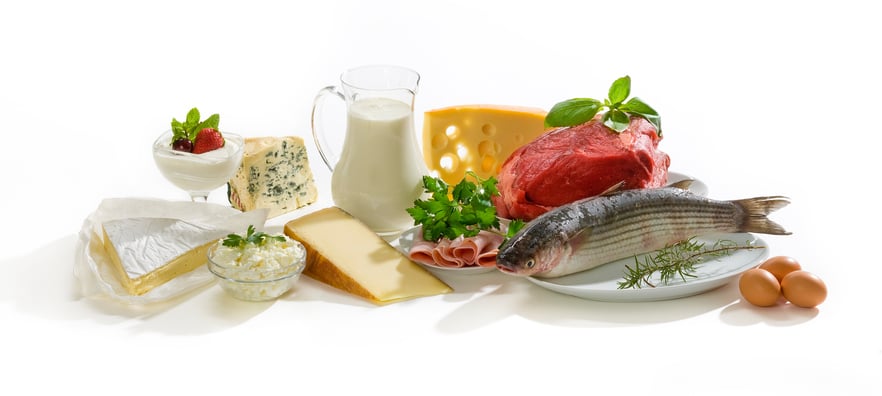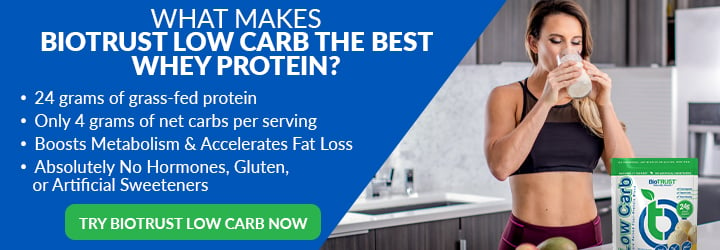Milk vs Meat: Which Protein Source is Better For You?

While there are few certainties in life—and even fewer when it comes to nutritional science—if there’s one thing we’re pretty confident about, it’s that high-protein diets are pretty awesome. For starters, protein-rich meals are very satiating, which means they help you feel full and satisfied. To this end, high-protein diets promote appetite control and reduce cravings.
And when protein replaces carbs and/or fats in the diet, it helps increase metabolism because it takes more calories for the body to digest and use protein (called the thermic effect of feeding).
Altogether, it’s no surprise that consistently sticking to a high-protein diet tends to lead to less food intake, better diet quality, more weight and fat loss, more calorie-burning lean muscle, and a healthier metabolic rate compared to “normal” intakes of protein.
And when it comes to protein, two of the first images that come to mind are likely meat and milk, which are synonymous with protein and muscles. While it’s rarely questioned, it does make you wonder, when it comes to dairy vs meat protein, which is better? Is one better than the other?
Before we dive into this protein faceoff pitting milk vs meat, it’s worth pointing out that the average American consumes only about 16% of calories from protein. (That’s roughly half of “optimal,” which may be as high as 35%.) In other words, the writing is on the wall. Most people are not taking advantage of the benefits of high-protein diets.1,2 To me, this is clear evidence that, for most people, a high-quality protein supplement is foundational for optimizing health, aging, body composition, and performance.
The Quality of Your Protein
When it comes to optimizing protein intake, protein quality is the name of the game. That is, it’s best to emphasize “high-quality” protein sources. But what the heck does high-quality mean? Good question.
The term protein quality refers to the balance of amino acids (the “building blocks” of protein), the digestibility of the protein (to release its constituent amino acid absorption), and the availability of the absorbed amino acids. When looking at the amino acids, protein quality places particular emphasis on the “essential” amino acids. Or, those the body cannot produce and must get through the diet. Confused? The take-home point here is that you want to emphasize high-quality proteins because they provide abundant amounts of usable protein and, in particular, essential amino acids.
Typically, protein quality has been measured using the protein digestibility corrected amino acid score (PDCAAS). And more recently, the digestible indispensable amino acid score, or DIAAS, has been suggested to be a superior scale. You don’t have to remember the alphabet soup. What you do need to know is that animal-based proteins, such as milk, eggs, and beef rank at the top with the highest scores. For instance, DIAAS scores for whey, eggs, and beef are all above 100%. Vegetarian proteins (such as beans, rice, and peas), on the other hand, typically fall below 80%.
Another way to look at it is that high-quality, animal-based proteins deliver a higher protein density along with a lower energy (calorie) content compared to plant-based proteins. What’s more, animal-based proteins provide a concentrated source of all the essential amino acids while plant-based foods are typically limited in one or more of them.
Along those lines, high-quality animal proteins—including both milk and beef—are typically all regarded in the same light. Having said that, there are some slight differences when it comes to PDCAAS and DIAAS between dairy and meat proteins. For instance, milk scores a perfect 1.00 on the PDCAAS scale while beef trails slightly at 0.92. In terms of DIAAS scores, milk sets the bar at 1.32, and beef is at 1.10.
With that in mind, you could make the argument that milk holds a slight edge. But the fact is, practically speaking, there really is no difference, at least for mere mortals like you and me. You see, beef and milk are both effective at maximally stimulating protein synthesis (which is a very good indicator of protein quality and effectiveness). Nonetheless, milk may be an advantageous option at certain times (such as before or after exercise) because it may have some “faster acting” properties.3
The Benefits of Meat and Milk
Even though we’re talking about protein, there’s more to the story…
Beef’s Big 10. In addition to protein, beef packs quite the nutritional punch, featuring 10 vital nutrients:
- Iron, which helps your body use oxygen
- Choline, which is an essential micronutrient that plays key roles in nervous system development, brain health, cognitive function, memory, muscle function, mood, and methylation
- Selenium, which plays an important role in the body’s antioxidant defense network
- Zinc, which helps maintain a healthy immune system and functions in hundreds of metabolic reactions
- Vitamins B6 and B12, which help energize the brain and maintain healthy cognitive function
- Phosphorus, which helps build bones and teeth
- Niacin, which supports energy production and metabolism
- Riboflavin, which helps convert food into energy
- Creatine, which helps fuel the brain and muscles and enhances mental and physical performance
- When you choose beef from grass-fed animals, which we recommend, you’ll also get a healthy dose of conjugated linoleic acid (CLA), which helps reduce body fat, increase calorie-burning muscle, and support the immune system.
What’s in your glass? Likewise, when you drink milk, you’re getting more than high-quality protein:
- Calcium, which is important for bones, muscles, and your heart, goes hand-in-hand with milk. In fact, dairy is the top source of calcium for Americans.
- A glass of milk contains as much potassium as a small banana.
- Milk is one of the few food sources of vitamin D. Considering the widespread prevalence of vitamin D deficiency, this is a feather in milk’s cap.
- Milk is also a good source of vitamin A, which is important for immune function and healthy, glowing skin.
- Like beef, milk also provides noteworthy amounts of phosphorus, B12, riboflavin, and niacin. Likewise, organic milk from grass-fed cows, which we’d recommend for the same reasons as beef, is also one of the best (and few) dietary sources of CLA.
Other things to note in this protein faceoff:
- Don’t fear the fat. Recent research shows that full-fat dairy consumption is related to less belly fat and better markers of cardiometabolic health, including blood pressure, cholesterol, triglycerides, and glycemic control. Not only that, researchers believe these better health outcomes may actually be brought on, at least in part, by dairy saturated fats.48
- Protein density. Let’s talk protein density for a minute. By that I mean the amount of protein relative to the number of calories consumed. For example, a 3-ounce serving of sirloin (< 10 grams of fat) provides about 25 grams of protein and about 180 calories. By comparison, a glass of whole milk provides 8 grams of protein and 150 calories. For what it’s worth, fat-free milk (which I wouldn’t necessarily recommend) provides 8 grams of protein and 80 calories. Either way you look at it, beef is a more concentrated source of protein.
- Consider your sensitive side. Of course, you can’t have a discussion about dairy without mentioning the possibility of milk sensitivities, whether it’s FODMAP (e.g., lactose) or protein-related (e.g., casein). While it’s certainly possible, beef food sensitivities are less common.
- Dairy isn’t a one-man show. Although the discussion has been relegated to milk, there are other dairy-based foods worth mentioning. For example, Greek yogurt is a more concentrated source of protein than milk. In fact, on the protein density scale, it ranks on par with beef. What’s more, both Greek-style and traditional yogurt pack probiotics, which are tied to numerous health benefits. Not only that, probiotics digest the sugars in milk, making them a more palatable option for folks with lactose-related milk sensitivities. Of course, one of the protein components in milk is called whey, which is considered by many to be the “gold standard” protein source. Along these lines, a high-quality whey protein supplement is an excellent option for folks from all walks of life looking to optimize health, aging, body composition, and performance.
And the Winner Is…
At this point, I’m curious, which do you think is the “winner” of this milk vs meat protein faceoff? From a protein quality standpoint, they’re both great, yet milk has a slight edge. But like we talked about, those differences are marginal at best, practically speaking. Beyond that, when you consider that beef is a more concentrated source of protein—not to mention the additional nutrients packaged in beef—I’m going to have to give the nod to red meat.
Don’t worry, milk lovers, I’m not the type of guy who’s going to say that everyone should run the other way from dairy. In fact, I buy my daughter organic full-fat cow’s milk from the farmers’ market, and I eat organic Greek yogurt and use a natural milk-based protein supplement daily.







